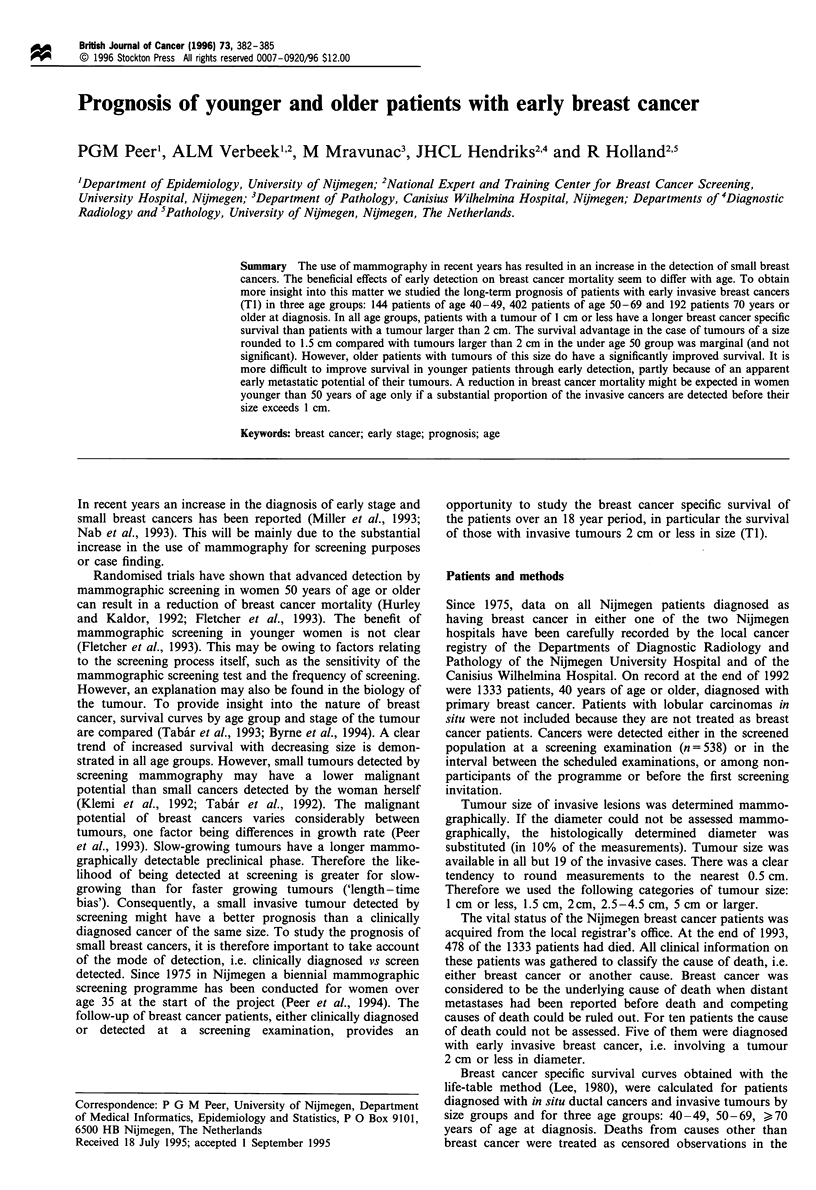Abstract
The use of mammography in recent years has resulted in an increase in the detection of small breast cancers. The beneficial effects of early detection on breast cancer mortality seem to differ with age. To obtain more insight into this matter we studied the long-term prognosis of patients with early invasive breast cancers (T1) in three age groups: 144 patients of age 40-49, 402 patients of age 50-69 and 192 patients 70 years or older at diagnosis. In all age groups, patients with a tumour of 1 cm or less have a longer breast cancer specific survival than patients with a tumour larger than 2 cm. The survival advantage in the case of tumours of a size rounded to 1.5 cm compared with tumours larger than 2 cm in the under age 50 group was marginal (and not significant). However, older patients with tumours of this size do have a significantly improved survival. It is more difficult to improve survival in younger patients through early detection, partly because of an apparent early metastatic potential of their tumours. A reduction in breast cancer mortality might be expected in women younger than 50 years of age only if a substantial proportion of the invasive cancers are detected before their size exceeds 1 cm.
Full text
PDF



Selected References
These references are in PubMed. This may not be the complete list of references from this article.
- Byrne C., Smart C. R., Chu K. C., Hartmann W. H. Survival advantage differences by age. Evaluation of the extended follow-up of the Breast Cancer Detection Demonstration Project. Cancer. 1994 Jul 1;74(1 Suppl):301–310. doi: 10.1002/cncr.2820741315. [DOI] [PubMed] [Google Scholar]
- Ciatto S., Zappa M. A prospective study of the value of mammographic patterns as indicators of breast cancer risk in a screening experience. Eur J Radiol. 1993 Sep;17(2):122–125. doi: 10.1016/0720-048x(93)90048-r. [DOI] [PubMed] [Google Scholar]
- Fletcher S. W., Black W., Harris R., Rimer B. K., Shapiro S. Report of the International Workshop on Screening for Breast Cancer. J Natl Cancer Inst. 1993 Oct 20;85(20):1644–1656. doi: 10.1093/jnci/85.20.1644. [DOI] [PubMed] [Google Scholar]
- Hellman S. Karnofsky Memorial Lecture. Natural history of small breast cancers. J Clin Oncol. 1994 Oct;12(10):2229–2234. doi: 10.1200/JCO.1994.12.10.2229. [DOI] [PubMed] [Google Scholar]
- Hurley S. F., Kaldor J. M. The benefits and risks of mammographic screening for breast cancer. Epidemiol Rev. 1992;14:101–130. doi: 10.1093/oxfordjournals.epirev.a036082. [DOI] [PubMed] [Google Scholar]
- Klemi P. J., Joensuu H., Toikkanen S., Tuominen J., Räsänen O., Tyrkkö J., Parvinen I. Aggressiveness of breast cancers found with and without screening. BMJ. 1992 Feb 22;304(6825):467–469. doi: 10.1136/bmj.304.6825.467. [DOI] [PMC free article] [PubMed] [Google Scholar]
- Miller B. A., Feuer E. J., Hankey B. F. Recent incidence trends for breast cancer in women and the relevance of early detection: an update. CA Cancer J Clin. 1993 Jan-Feb;43(1):27–41. doi: 10.3322/canjclin.43.1.27. [DOI] [PubMed] [Google Scholar]
- Nab H. W., Voogd A. C., Crommelin M. A., Kluck H. M., vd Heijden L. H., Coebergh J. W. Breast cancer in the southeastern Netherlands, 1960-1989: trends in incidence and mortality. Eur J Cancer. 1993;29A(11):1557–1559. doi: 10.1016/0959-8049(93)90294-p. [DOI] [PubMed] [Google Scholar]
- Peer P. G., Holland R., Hendriks J. H., Mravunac M., Verbeek A. L. Age-specific effectiveness of the Nijmegen population-based breast cancer-screening program: assessment of early indicators of screening effectiveness. J Natl Cancer Inst. 1994 Mar 16;86(6):436–441. doi: 10.1093/jnci/86.6.436. [DOI] [PubMed] [Google Scholar]
- Peer P. G., van Dijck J. A., Hendriks J. H., Holland R., Verbeek A. L. Age-dependent growth rate of primary breast cancer. Cancer. 1993 Jun 1;71(11):3547–3551. doi: 10.1002/1097-0142(19930601)71:11<3547::aid-cncr2820711114>3.0.co;2-c. [DOI] [PubMed] [Google Scholar]
- Rosen P. R., Groshen S., Saigo P. E., Kinne D. W., Hellman S. A long-term follow-up study of survival in stage I (T1N0M0) and stage II (T1N1M0) breast carcinoma. J Clin Oncol. 1989 Mar;7(3):355–366. doi: 10.1200/JCO.1989.7.3.355. [DOI] [PubMed] [Google Scholar]
- Rosner D., Lane W. W. Node-negative minimal invasive breast cancer patients are not candidates for routine systemic adjuvant therapy. Cancer. 1990 Jul 15;66(2):199–205. doi: 10.1002/1097-0142(19900715)66:2<199::aid-cncr2820660202>3.0.co;2-l. [DOI] [PubMed] [Google Scholar]
- Tabar L., Duffy S. W., Burhenne L. W. New Swedish breast cancer detection results for women aged 40-49. Cancer. 1993 Aug 15;72(4 Suppl):1437–1448. doi: 10.1002/1097-0142(19930815)72:4+<1437::aid-cncr2820721405>3.0.co;2-m. [DOI] [PubMed] [Google Scholar]
- Tabàr L., Fagerberg G., Duffy S. W., Day N. E., Gad A., Gröntoft O. Update of the Swedish two-county program of mammographic screening for breast cancer. Radiol Clin North Am. 1992 Jan;30(1):187–210. [PubMed] [Google Scholar]


